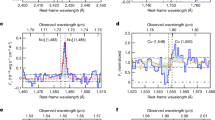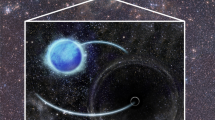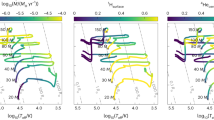Abstract
Arising from: T. A. Boroson & T. R. Lauer Nature 458, 53–55 (2009)10.1038/nature07779; Boroson & Lauer reply
It has been proposed that when the peaks of the broad emission lines in active galactic nuclei (AGNs) are significantly blueshifted or redshifted from the systemic velocity of the host galaxy, this could be a consequence of orbital motion of a supermassive black-hole binary (SMBB)1. The AGN J1536+0441 ( = SDSS J153636.22+044127.0) has recently been proposed as an example of this phenomenon2. It is proposed here instead that J1536+0441 is an example of line emission from a disk. If this is correct, the lack of clear optical spectral evidence for close SMBBs is significant, and argues either that the merging of close SMBBs is much faster than has generally been hitherto thought, or if the approach is slow, that when the separation of the binary is comparable to the size of the torus and broad-line region, the feeding of the black holes is disrupted.
Similar content being viewed by others
Main
Galaxies grow through mergers, and as all massive galaxies contain supermassive black holes, the formation of SMBBs will be common1,3,4. Close SMBBs, with orbital velocities ∼0.01c, are expected to last long enough to be observed1,3. It was proposed1 that such close binaries could be detected from velocity shifts of their broad-line region (BLR) line profiles, and pointed out that velocity shifts of the peaks of low-ionization broad lines are common1,4,5.
There are two testable predictions of this model: first, the radial velocities of the peaks in the line profiles will shift on the orbital timescale of the SMBB6, and second, as all AGNs vary, if there are two separate BLRs, the line fluxes of the two peaks will vary independently7. The prototypical displaced BLR peak AGN 3C 390.3 fails both these tests. The radial velocity signature of orbital motion has been detected6,8 but the velocity changes are incompatible with an SMBB and are instead consistent with orbital motion of features in a non-azimuthally-symmetric disk. The peaks in 3C 390.3 initially seemed to be varying independently on timescales longer than the light-crossing timescale7, but an SMBB is strongly ruled out by better-sampled monitoring9,10, which shows that on a light-crossing time the peaks vary simultaneously as expected for a disk. The longer timescale profile changes in these AGNs are consistent with orbital motion of clumps in a disk11. The profiles are consistent with theoretical line emission profiles expected from disks12, but the disks are generally not azimuthally symmetric and it is common for one peak to be significantly stronger than the other1,4,5,12.
The Balmer lines of J1536+0441 have a strong blueshifted peak2. The Hβ profile is shown in Fig. 1. Boroson and Lauer2,13 interpret J1536+0441 as a SMBB. I argue here, however, that just as the Balmer line profiles in previous SMBB candidates have been shown to be due to disk emission, so too the Balmer line profile of J1536+0441 probably arises from disk emission. This has also been independently proposed14,15.
The latter is taken from the mean spectrum in figure 3 of ref. 11 and scaled as described the text. The dotted red lines illustrate the effects on the peaks in the Arp 102B profile if they are changed by 1σ (based on the r.m.s. spectrum in figure 4b of ref. 11). The contribution of lower-velocity gas at the systemic velocity in Arp 102B has been omitted.
Although J1536+0441 represents an extremum among AGNs selected as ‘quasars’ by the SDSS, its line profiles are not unique among AGNs in general. The AGN 0945+076, for example, has shown a nearly identical Hβ profile (compare Fig. 1 with the Hβ profile of 0945+0761). To qualitatively illustrate the non-uniqueness of J1536+0441, Fig. 1 includes part of the scaled Hβ profile of the well-known disk emitter Arp 102B. Fitting disk models to theoretical double-peaked profiles invariably shows that there is an extra component of gas at the systemic velocity12, so the spectral region with a width corresponding to that of the high-velocity wings of the [O iii] 5,007 Å line has been excluded around rest-frame Hβ. The width of the Arp 102B spectrum has been reduced by 34% to make the velocity of the blueshifted peak in J1546+0441 match that of the blueshifted peak in the mean Arp 102B spectrum. This is well within the range of line widths seen among disk-like emitters. The uncertainty in the width scaling is about ±5%. The flux has been scaled by minimizing residuals away from the peaks of the broad lines and away from the contaminating [O iii] 5,007 Å lines. The profiles of broad disk-like lines vary strongly, so we do not expect a perfect match between any two objects a given time. The peaks of Arp 102B are particularly variable11. The differences in the peak fluxes are only about 1σ from the scaled Arp 102B mean profile (Fig. 1). More recent spectra of J1546+044113,15 (especially of Hα) show better agreement in the red peak.
Clearly, the most rigorous test of the competing hypotheses is line profile variability2,13. If this verifies that the Hβ profile of J1536+0441 is the result of normal disk emission, it has significant implications for the evolution of SMBBs, as J1536+0441 is the only candidate so far for a sub-parsec SMBB out of ∼17,500 AGNs with z < 0.70 in the SDSS2,13. Because SMBB formation must be common, the absence of clear evidence for close SMBBs in AGNs needs to be explained. It suggests either that the lifetime of close SMBBs is considerable shorter than originally thought, or that they are long-lived and have their feeding interrupted so that activity is greatly reduced.
References
Gaskell, C. M. Quasars as supermassive binaries. Liége Int. Astrophys. Colloq. 24, 473–477 (1983)
Boroson, T. A. & Lauer, T. R. A candidate sub-parsec supermassive binary black hole system. Nature 458, 53–55 (2009)
Begelman, M. C., Blandford, R. D. & Rees, M. J. Massive black hole binaries in active galactic nuclei. Nature 287, 307–309 (1980)
Gaskell, C. M. in Jets from Stars and Galactic Nuclei (ed. Kundt, W.) 165–195 (Springer, 1996)
Gaskell, C. M. & Snedden, S. A. The optical case for a disk component of BLR emission. ASP Conf. Ser. 175, 157–162 (1999)
Gaskell, C. M. Evidence for binary orbital motion of a quasar broad-line region. Astrophys. J. 464, L107–L110 (1996)
Gaskell, C. M. in Active Galactic Nuclei (eds Miller, H. R. & Wiita, P. J.) 61–67 (Springer, 1988)
Eracleous, M., Halpern, J. P., Gilbert, A. M., Newman, J. A. & Filippenko, A. V. Rejection of the binary broad-line region interpretation of double-peaked emission lines in three active galactic nuclei. Astrophys. J. 490, 216–226 (1997)
Dietrich, M. et al. Steps toward determination of the size and structure of the broad-line region in active galactic nuclei. XII. Ground-based monitoring of 3C 390.3. Astrophys. J. 115 (Suppl.). 185–202 (1998)
O’Brien, P. T. et al. Steps toward determination of the size and structure of the broad-line region in active galactic nuclei. XIII. Ultraviolet observations of the radio-galaxy 3C 390.3. Astrophys. J. 509, 163–176 (1998)
Sergeev, S. G., Pronik, V. I. & Sergeeva, E. S. Arp 102B: variability patterns of the Hα line profile as evidence for gas rotation in the broad-line region. Astron. Astrophys. 356, 41–49 (2000)
Eracleous, M. & Halpern, J. P. Completion of a survey and detailed study of double-peaked emission lines in radio-loud active galactic nuclei. Astrophys. J. 599, 886–908 (2003)
Lauer, T. & Boroson, T. HST images and KPNO spectroscopy of the binary black hole candidate SDSS J153636.22+044127.0. Astrophys. J. 703, 930–938 (2009)
Chornock, R. et al. SDSS J1536+0441: an extreme “double-peaked emitter,” not a binary black hole. Astron. Telegr. 1955, (2009)
Chornock, R. et al. The quasar SDSS J1536+0441: an unusual double-peaked emitter. Preprint at 〈http://arXiv.org/abs/0906.0849〉 (2009)
Author information
Authors and Affiliations
Ethics declarations
Competing interests
The author declares no competing financial interests.
PowerPoint slides
Rights and permissions
About this article
Cite this article
Gaskell, C. Close supermassive binary black holes. Nature 463, E1 (2010). https://doi.org/10.1038/nature08665
Received:
Accepted:
Issue Date:
DOI: https://doi.org/10.1038/nature08665
This article is cited by
-
A possible close supermassive black-hole binary in a quasar with optical periodicity
Nature (2015)
-
Together at last
Nature Physics (2014)
-
A tight duo in a trio of black holes
Nature (2014)
-
Boroson and Lauer reply
Nature (2010)
Comments
By submitting a comment you agree to abide by our Terms and Community Guidelines. If you find something abusive or that does not comply with our terms or guidelines please flag it as inappropriate.




